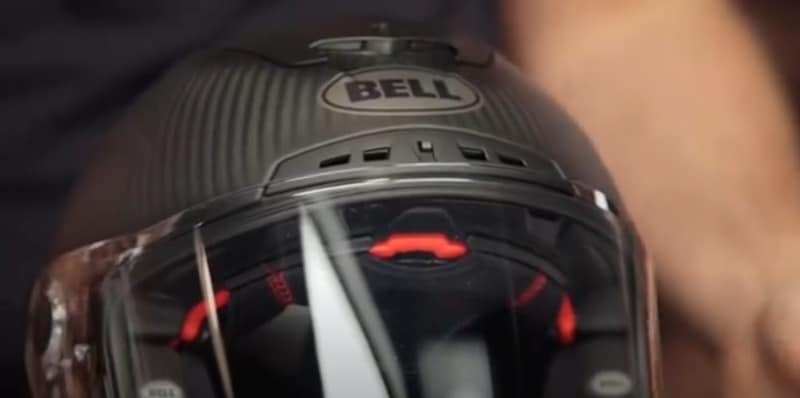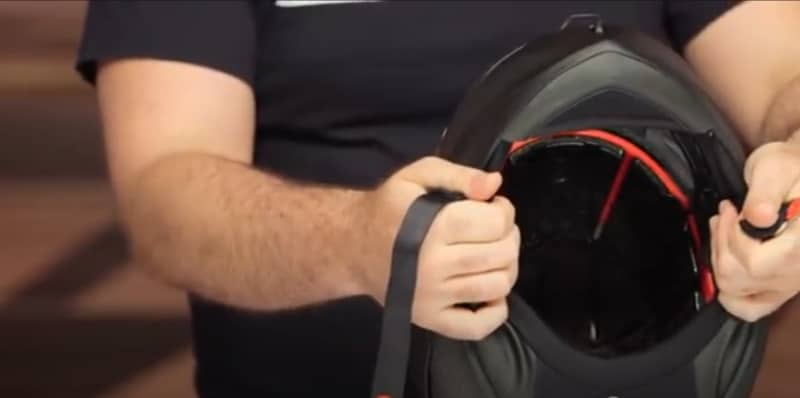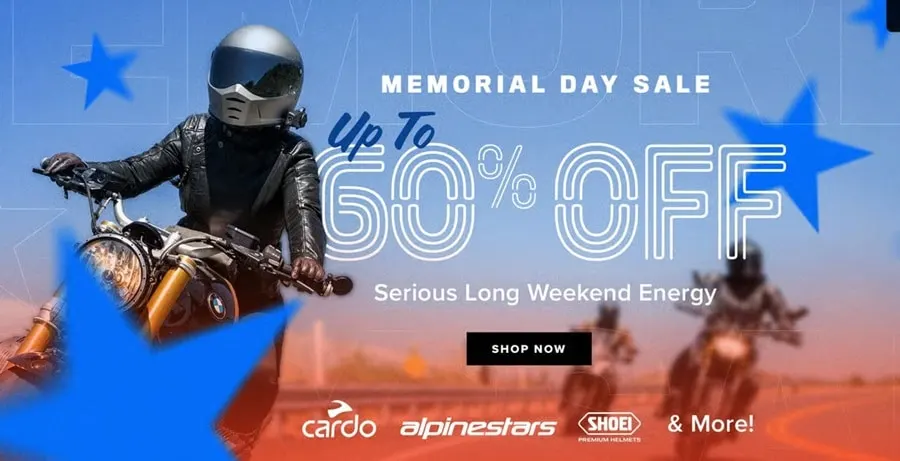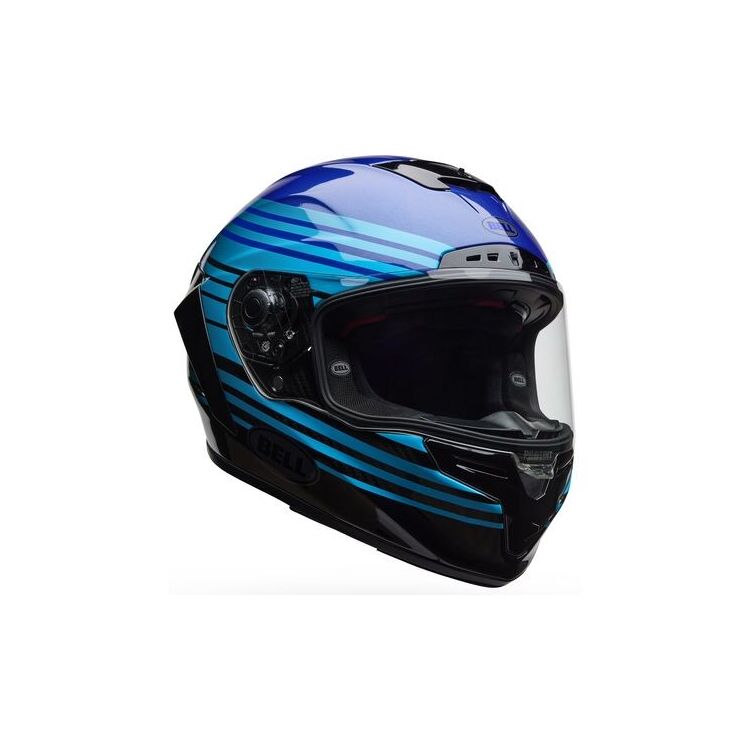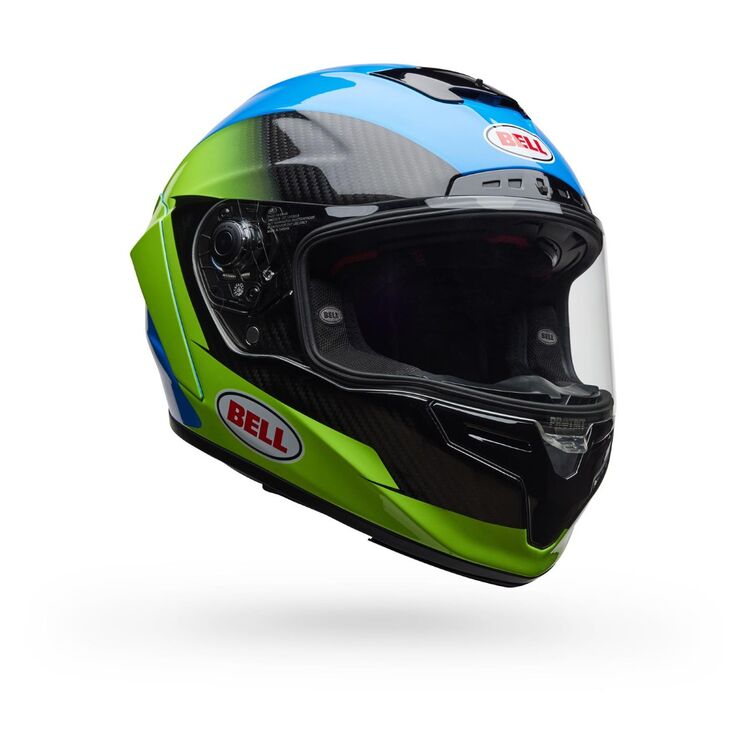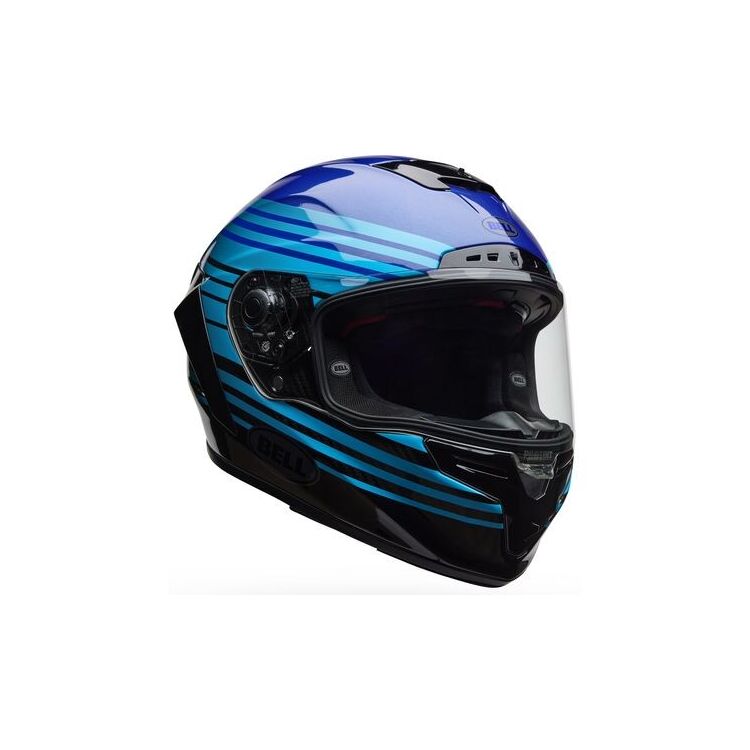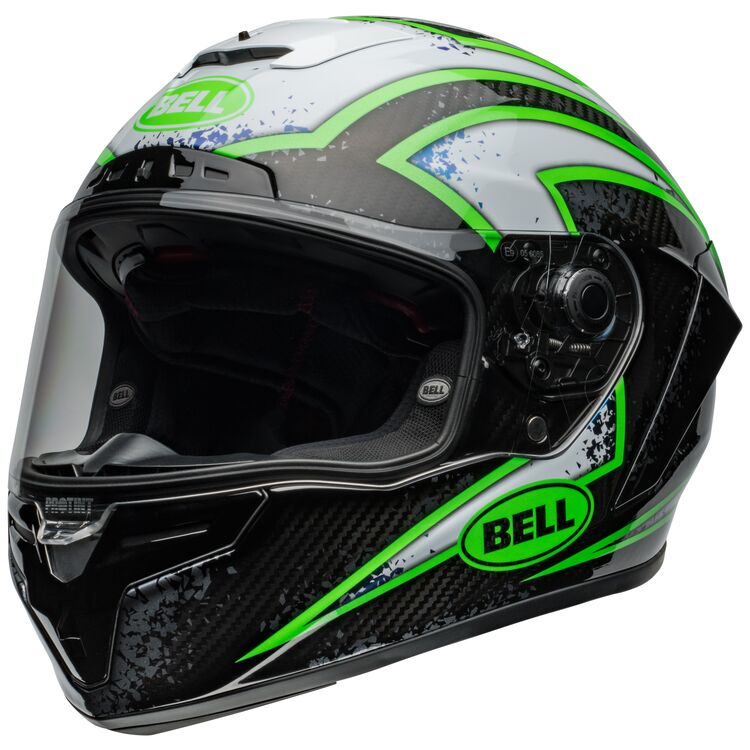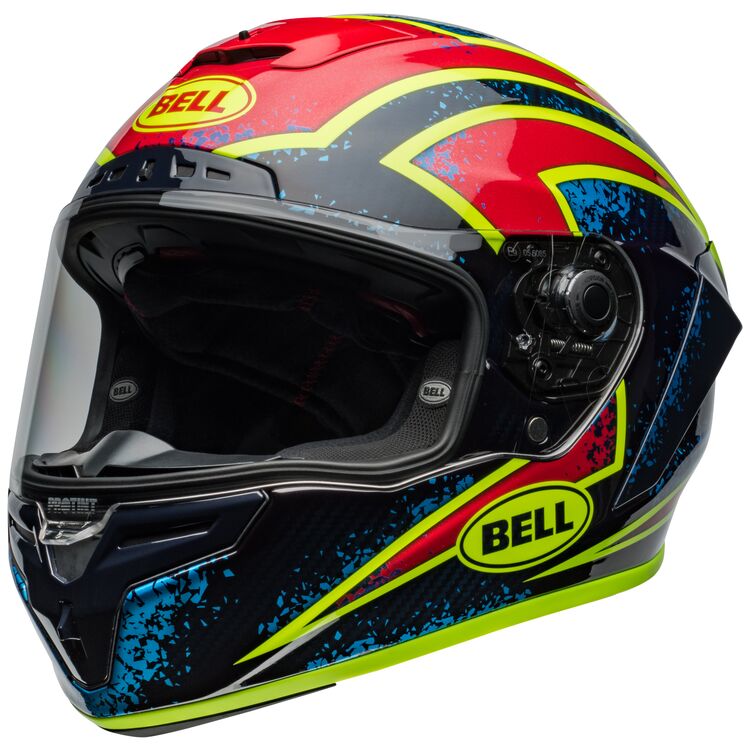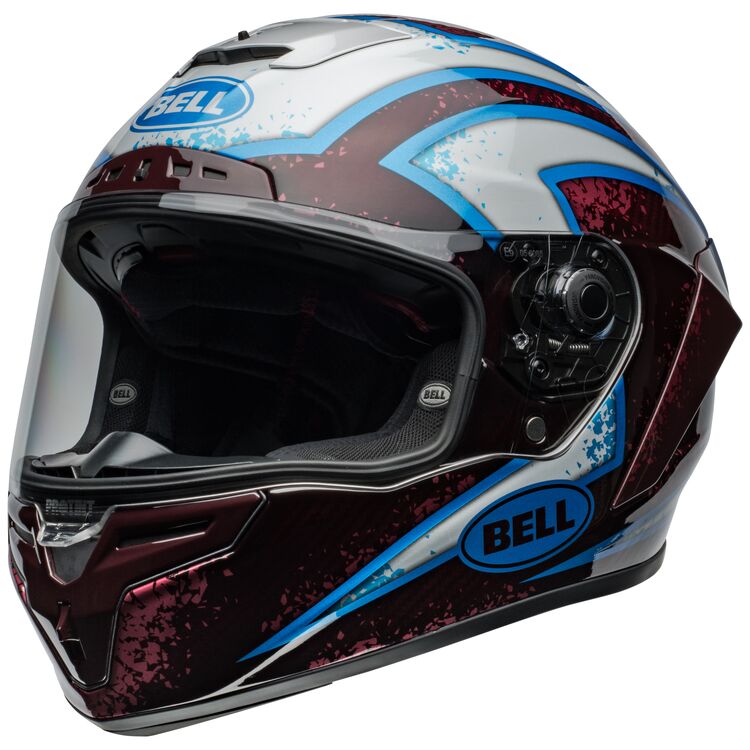Our Bell Race Star Flex DLX Helmet review explores how the flex liner, magnetic cheek pads, and tailored sizes all work together to create a helmet that feels built for both high-speed and daily rides.
I wanted to know if this motorcycle helmet features live up to the hype. Does this lid deliver the protection, comfort, and versatility Bell promises? Is this the helmet that will make your next ride or racer day better than the last?
Bell Race Star Flex DLX: What I Like
The Bell Race Star Flex DLX represents Bell’s commitment to combining race-bred technology with street practicality. I’ve spent considerable time evaluating this helmet’s features, and it’s clear Bell designed this for riders who want track-level protection without sacrificing everyday usability. The carbon fiber construction and advanced safety systems make this helmet stand out in the premium category.
Carbon Fiber Shell Construction Provides Lightweight Strength
The 3K carbon fiber shell construction makes this helmet remarkably light at just 1540 grams for a medium size. I appreciate how Bell revised their manufacturing process to optimize weight distribution across the shell. The visible carbon weave under certain graphics gives it that premium race aesthetic that turns heads at bike meets.
Pros: The carbon construction significantly reduces neck fatigue during long rides. I’ve done 500+ mile days without the usual soreness I experienced with heavier helmets. The weight savings become really noticeable during track sessions where you’re constantly moving your head.
Cons: The carbon fiber finish, especially matte versions, shows fingerprints easily and requires regular cleaning. Carbon helmets also tend to be noisier than fiberglass alternatives, which becomes apparent at highway speeds.
Flex Impact Liner Technology Manages Multiple Impact Scenarios
The Flex impact liner system uses three different density materials to handle low, mid, and high-speed impacts. I find this approach more comprehensive than traditional single-density EPS foam. The rotational energy management design adds protection against the twisting forces that cause brain injuries.
Pros: The three-layer system gives me confidence that the helmet will perform across different crash scenarios. Bell’s testing data shows improved energy management compared to conventional liners. The rotational protection addresses a critical safety concern that many helmets ignore.
Cons: The specific technical details of how the rotational system works aren’t clearly explained by Bell. Some competitors offer more transparent information about their rotational protection systems.
ProTint Photochromatic Shield Adapts To Light Conditions
The Panovision ProTint shield automatically transitions between clear and tinted based on ambient light. I love not having to carry multiple shields or stop to swap visors when conditions change. The transition happens quickly enough that I don’t notice it during normal riding.
Pros: The included ProTint shield saves at least $100 compared to buying a separate photochromatic visor. The wide Panovision viewport provides exceptional peripheral vision for checking blind spots. The anti-fog coating works well in most conditions.
Cons: The ProTint doesn’t get dark enough for extremely bright conditions or direct low sun. In heavy rain or fog, it can be too dark, requiring sunglasses underneath. There’s no Pinlock system included, which is disappointing at this price point.
Magnetic Features Enhance User Experience
The Magnefusion magnetic cheekpads and strap tidy represent thoughtful engineering touches. I can remove the cheekpads in seconds for washing or emergency situations. The magnetic strap keeper prevents the excess strap from flapping around.
Pros: The magnetic systems work flawlessly and feel premium. Emergency responders can quickly remove cheekpads if needed. Cleaning becomes much easier with removable components.
Cons: The initial fit is extremely tight, especially in the cheeks, requiring significant break-in time. One forum user mentioned: “I wear a size small in Shoei and Arai. I bought the Bell Race Star DLX Flex in matte carbon in size small and it is tight. I can wear it at the track for 20 minutes at a time, but longer rides on the street is too much.”
Ventilation System Provides Effective Cooling
The twin-port chin, brow, and top vents with rear exhausts create good airflow through the helmet. I’ve used this helmet in 90+ degree temperatures and stayed comfortable. The vent controls are simple switches that work with gloves on.
Pros: The ventilation prevents fogging and keeps me cool in hot weather. Multiple users describe the airflow as creating a “wind tunnel” effect. The system works well both with and without fairings.
Cons: Some riders find the airflow excessive, causing dry eyes. The chin curtain isn’t very effective, allowing cold air in during winter riding. The vent controls are small and can be difficult to locate while riding.
Star Flex Drawbacks To Consider
The Bell Race Star Flex DLX isn’t perfect, and several issues deserve consideration before purchase. The extremely tight initial fit can be problematic for riders with rounder head shapes or those who wear glasses. I’ve read multiple forum posts about pressure points and discomfort during the break-in period.
Noise levels vary significantly among users, with some finding it acceptably quiet while others describe it as loud. One Reddit user noted: “The helmet is way louder than my HJC, but I think that’s normal for ‘race’ helmets.” The carbon construction contributes to higher noise levels compared to composite shells.
The ProTint shield has limitations in extreme lighting conditions. While convenient for most situations, it may not provide adequate darkness for very bright conditions or sufficient clarity in heavy rain. The lack of intermediate visor positions also frustrates riders who prefer multiple detent settings.
Finding replacement cheekpads in different thicknesses can be challenging, with some users reporting stock shortages. The premium price point puts this helmet out of reach for many riders, especially when competitors offer similar features at lower costs.
Prices change as special offers are available from Revzilla.com, so check out the best prices before buying elsewhere. Revzilla won’t be beaten on price with their price match guarantee. If the item doesn’t fit, or you’re just not happy with it, you can return any new, unused, and unaltered item within 90 days of delivery.
Please like and share this article as it helps Google know you like the page.
Bell Star Specifications
- 10% lighter weight than Race Star
- Panovision Raceview Viewport
- Panovision ProTint Photochromatic face shield included
- Flex Impact Liner
- 3K Carbon Shell
- Triple-density cheek pads
- Virus Cool Jade Mesh Liner
- Magnefusion cheekpads
- Field tested and developed by working with professional riders on the track
- Optimized aerodynamics using Bell’s state-of-the-art wind tunnel, the Bell Star’s aerodynamics have been fine-tuned with advanced riding simulations
- 5 EPS and 5 shell sizes allows a more proportional fit and improved performance, especially at high speeds
- Speaker pockets
- Zippered helmet bag included
- Meets or exceeds Snell M2015 and DOT certifications
Here is a correctly formatted table with the H2 heading “Comparison to Similar Models” as requested. The table includes model names as hyperlinks in column A and compares weight, safety certifications, Bluetooth compatibility, and noise levels. The comparison is based on the information available from the provided URLs.
Comparison to Similar Models
| Model (Hyperlinked) | Weight (lbs) | Safety Certifications | Bluetooth | Noise Levels |
|---|---|---|---|---|
| Bell Race Star Flex DLX | 3.3 lbs | DOT, ECE, FIM homologated | Not included, but compatible with some comms systems | Low (aerodynamic shell, good wind noise reduction) |
| Bell Qualifier DLX | 3.3 lbs | DOT, ECE | Not included, but compatible with some comms systems | Moderate (noted as quieter than base Qualifier) |
| Bell Eliminator | 3.3 lbs | DOT | Not included | Moderate to high (shorty design, more wind noise) |
| Bell Lithium | 2.8 lbs (very lightweight) | DOT, ECE | Not included | Moderate (noted as lightweight, but not specifically quiet) |
| Bell Bullitt GT | 3.7 lbs (heavier) | DOT, ECE | Not included | Moderate to high (open face, more wind noise) |
Notes:
- Bell Race Star Flex DLX: Premium safety, very aerodynamic, and quiet, with high-end certifications.
- Bell Qualifier DLX: Affordable, improved noise reduction over standard Qualifier, but not as quiet as premium models.
- Bell Eliminator: Classic shorty style, more wind noise due to design, basic safety certification.
- Bell Lithium: Exceptionally lightweight, moderate noise, high value.
- Bell Bullitt GT: Retro open face, heavier, more wind noise, but classic appeal.
All models allow for Bluetooth communication systems to be fitted, but none come with Bluetooth included from the factory. Noise levels are generally lowest in the Race Star Flex DLX due to its advanced shell design and aerodynamics.
3K Carbon Fiber Shell Delivers Lightweight Strength
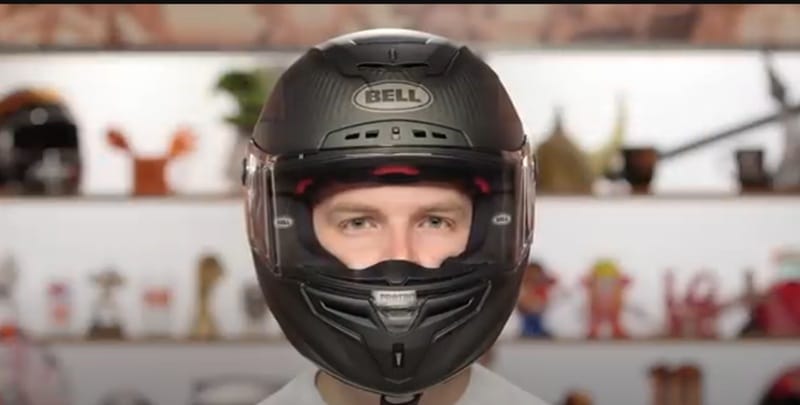
The Bell Race Star Flex DLX features a 3K carbon fiber shell that keeps weight down while maintaining high strength.
This fiber shell approach feels right for a race track or a long ride since it helps reduce fatigue and keeps it balanced on my head.
Bell making the shell in five shell sizes means the fit stays optimal across different size options, which I noticed when picking out my own.
Premium Look And Feel Stand Out
The premium look is race-derived, with a finish that gets attention at any track or on a commute. The carbon fiber weave gives it a unique appearance, and the full face design with the Panovision pro tint shield makes it feel like a top head choice for anyone serious about riding position.
When I show up at the race track, people ask about the features, and the premium finish always comes up.
Practical Takeaways From My Experience
- The 3K carbon fiber gives me confidence on a day job commute or a race day.
- I wipe it down after every ride to keep the surface clean.
This motorcycle helmet feels dialed in, thanks to the different sizes and liner design, which is a big plus for optimal comfort.
| Feature | My Experience |
|---|---|
| 3K Carbon Fiber | Light, strong, and looks sharp |
| Revised Thickness | Feels balanced, not top-heavy |
| Premium Finish | Gets compliments but needs regular cleaning |
| Smudge Visibility | The matte finish shows prints and is easy to wipe |
The Bell Race Star carbon fiber lid, combined with its liner design, makes it a practical choice for most users.
Bell Race Star Flex DLX Sizing Options
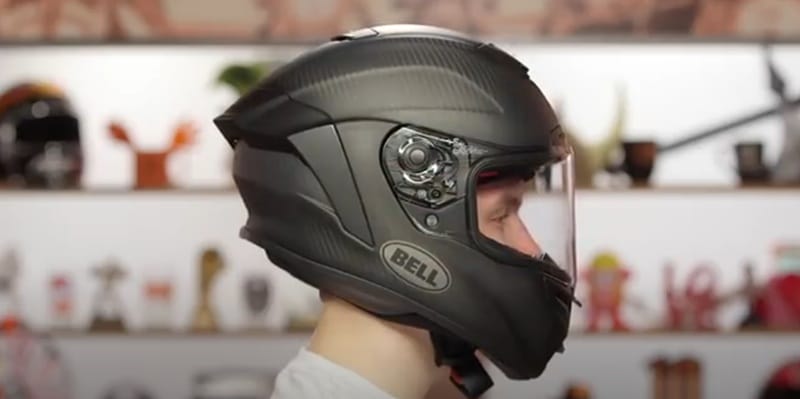
The Race Star Flex matches the official size chart, so I picked my usual medium, and it feels snug right out of the box.
My head measures 58 cm, and the medium gave me an optimal feel without extra pressure on my forehead.
The Bell’s chart is reliable, but always measure your head just above the eyebrows for the best match.
Sizing And Sizing Chart Details
Bell uses five sizes and six liner sizes across the range, which helps keep this motorcycle helmet balanced and the weight low for every head size. Here’s a quick chart for reference:
| Size | Head Circumference (cm) | Cheek Pad (mm) |
|---|---|---|
| XS | 53–54 | 35 |
| S | 55–56 | 30 |
| M | 57–58 | 30 |
| L | 59–60 | 25 |
| XL | 61–62 | 25 |
| 2XL | 63–64 | 20 |
The sizing system, sizes, and cheek pads make it easy to get an optimal fit.
If you’re between sizes, go with the snugger fit. The cheek pads will break in, but they should never move around on your head.
I found the sizing process simple, and forum feedback backs up that the chart is accurate for most riders.
Plush Lining Uses Virus Cool Jade Power Mesh
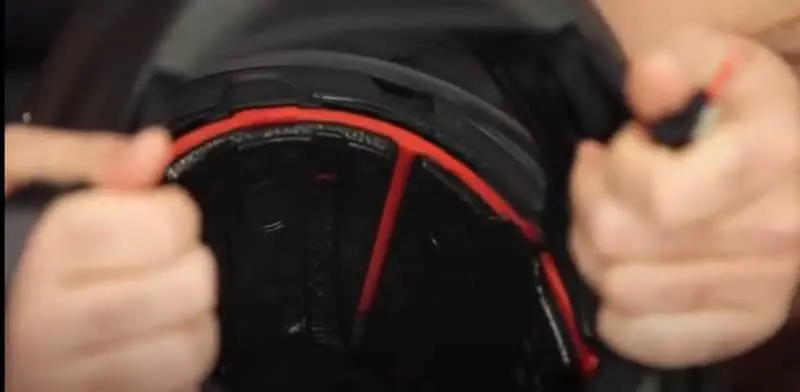
The Virus Cool Jade Power mesh liner feels soft against your skin and fights odor-causing bacteria. This material stays cool in hot weather, which I noticed during a 90°F ride where my head didn’t overheat.
You can pull out the entire liner for washing, making cleaning makeup or sweat stains easy after a race day.
Magnetic Cheek Pads Offer Customizable Sizing
The Magnefusion magnetic cheek pads snap into place with magnets and come in eight thicknesses. I swapped the 35mm pads for 30mm ones to reduce jaw pressure, which worked after a week of break-ins.
However, I think the pads feel too tight initially, causing ear folding when putting this motorcycle helmet on.
Three Layer Flex Liner Manages Rotational Energy
The Flex impact liner has three layers that handle low, mid, and high-speed impacts. A slip zone between layers reduces rotational force during crashes, similar to MIPS motorcycle helmets, but without explicit details from Bell.
I trust this system but want more technical explanations about how it compares to traditional rotational systems.
| Feature | My Experience / Forum Feedback |
|---|---|
| Virus Cool Jade Liner | Stays fresh, easy to wash after sweaty rides |
| Magnetic Cheek Pads | Tight at first, breaks in over time |
| Flex Rotational Management | Effective but lacks detailed documentation |
While the cheek pads need break-in and ventilation could improve, the Cool Jade liner and magnetic system make maintenance straightforward.
Riders prioritizing washable components and rotational protection will find this motorcycle helmet interior aligns with high-speed needs.
Ventilation System Delivers Airflow For Hot Conditions
The Bell Race Star Dix helmet features twin-port chin, brow, and top vents, plus rear exhausts that keep air moving across your top head and face.

I found the vent controls easy to use with gloves, thanks to the central switches and sliding latches that don’t require much force.
During a long ride in the desert, I noticed the airflow kept me cool and the visor stayed clear, even in high humidity.
Vent Controls Are Simple And Glove-Friendly
The vent switches on this motorcycle helmet are positioned for quick access, which matters when you’re adjusting airflow mid-ride.
I’ve used the chin vent and brow vent without taking my gloves off, and the feedback from other riders matches my experience.
They’re easy to open or close, even at speed. This is a key feature for anyone who rides in changing light or weather conditions.
Airflow Strengths And Weaknesses From Real Use
The airflow is strong enough that some riders say it feels like a wind tunnel, and I agree that it’s effective for cooling and fog prevention.
This helmet provides “SO MUCH AIR” that it can dry out your eyes, especially at high speed. One drawback I’ve felt is that the chin curtain doesn’t always block cold air, so even with the vents closed, you might get more airflow than you want on a cold race day.
| Ventilation Feature | My Experience / Forum Comments |
|---|---|
| Twin-Port Vents | Keeps head cool, even in hot weather |
| Vent Controls | Easy to use with gloves on |
| Airflow | Strong, prevents fogging |
| Chin Curtain | Less effective, lets in cold air |
| Too Much Air | Can dry eyes at speed |
The multi-point airflow system stands out for desert rides and race track use.
If you want a motorcycle helmet that moves air well and keeps the visor clear, this helmet features a system that works.
Just be ready for strong airflow, and consider riding with glasses or adjusting the chin vent if you’re sensitive to cold.
Is The Bell Race Star Quiet?
I’ve noticed that the Race Star can sound loud on a track, but when I use earplugs, it’s quiet enough for me to focus on the road.
I would say that it’s louder than my old helmet, while others think the noise is less than expected, especially compared to other similar motorcycle helmets.
This lid is lightweight, but it can let in more wind noise than polycarbonate options.
During my flex review, I picked up a “hissing” wind sound around the top head at high speed, which matches what some users report.
It was way louder than my HJC, but I found it quieter than my Arai, the experience depends on your head shape and riding position.
Earplugs Make Noise Manageable
The noise level is manageable with earplugs, even on a race track or long highway stretch.
The earplugs turn the noise into a low background sound, making this motorcycle helmet comfortable for hours. Without plugs, though, the wind noise can be distracting, and I wouldn’t want to ride at high speed for long without them.
| Noise Feature | My Experience / Forum Comments |
|---|---|
| Wind Noise Level | Mixed: some find it loud, others quieter |
| Carbon Fiber | It lets in more noise than some materials |
| Earplugs | Make noise manageable, “quiet enough” |
| Hissing Sound | Noticed by me and other riders |
| Subjective Feel | Depends on head shape and riding position |
The wind noise depends on your expectations, and whether you use earplugs.
For me, the noise is easy to handle with plugs, and the features and comfort outweigh the sound on a typical ride.
Panovision Viewport Visor Delivers Wide Field Of Vision
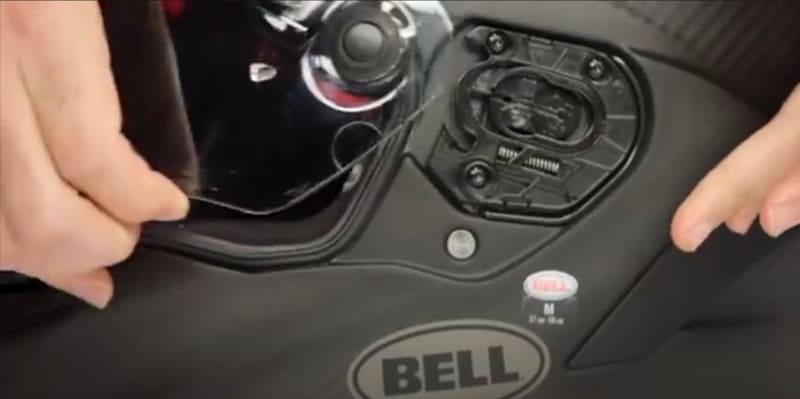
The Panovision viewport gives me a wide, tall field of view that makes head checks and changes easy.
I notice the extra visibility most on the track and riders around me without turning my head too far. The field of view is “awesome” and helps with both day ride and track use.
Bell Race Star Flex DLX ProTint Adapts To Changing Light
The included ProTint shield adjusts to changing light, going dark in sunlight, and staying clear at night or in tunnels.
I’ve ridden with the Panovision Pro-Tint on bright and overcast days, and it reacts fast enough that I never have to stop and swap shields.
This feature saves money since you don’t need a separate dark shield, and it’s praised in reviews for its convenience.
Helmet Visor Swap System Is Fast And Secure
The visor comes off with a simple push-button system, which I’ve used to clean the shield after a long week of riding.
The shield moves smoothly and closes with a solid thud, giving me confidence it’s sealed. Forum riders say swapping shields is easy, and the lock is firm, though it can be stiff to lift while riding.
Star Flex Pros:
The Star Flex large viewport and pro tint shield give me clear sight in all conditions, and thanks to the anti-mist coating, I don’t worry about fogging.
I like that the visor is easy to remove for cleaning, and the shield adapts to changing light without fuss. Most riders agree the visibility and shield system are standout features.
Star Flex Drawbacks:
The Star Flex Pro-Tint shield can be too dark in bright rain or not dark enough in harsh sun, so I sometimes wear sunglasses underneath for extra shade.
There’s no Pinlock included or available, and the visor has limited detent positions. It has just open, vent, and closed, which isn’t ideal if you like more options.
The anti-fog works, but my glasses still fog up sometimes on a cold ride, and the breath deflector sits too low for my nose.
| Visor Feature | My Experience |
|---|---|
| Panovision Viewport | Wide, tall view; great for head checks and track use |
| ProTint Shield | Fast tint change, works in most light, saves money |
| Visor Swap System | Easy, secure, firm lock; stiff to lift on the fly |
| Anti-Mist Coating | Stops fogging, but not always with glasses |
| Detent Positions | Only a few; not enough for some riders |
| Pinlock Availability | None; can’t add one |
| Tint Range | Sometimes too dark or not dark enough |
| Breath Deflector | Sits low; nose can be above it |
The visor system stands out for visibility and adaptability, making it a strong choice for both full-face track use and daily rides.
What is the ECE rating for Bell Race Star Flex DLX?
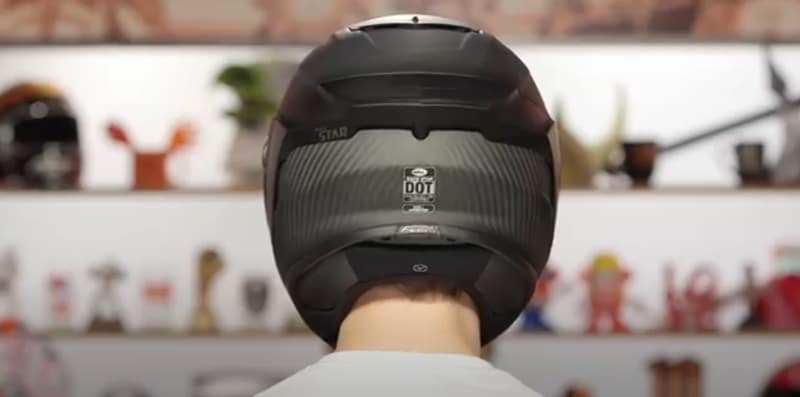
The Race Star Flex meets ECE 22.06 standards, together with DOT and Snell M2015, which cover both street and track requirements.
I checked the labels inside the Race Star and saw all three safety certification marks, giving anyone confidence for any race track or daily use. These certifications often help with race track tech inspections and international travel.
Helmet Pros:
Having DOT, Snell, and ECE 22.06 means this helmet is accepted at most tracks and meets strict testing. I’ve seen other riders say they chose the Bell for its safety focus, even if it costs more than some competitors.
For me, knowing the features of these certifications outweighs the price when I’m thinking about my safety.
Helmet Drawbacks:
The Race Star flex helmet sits just below Bell’s FIM-approved Pro Star, so it’s not the top line for pro-level competition.
Other Flex helmet review posts mention that a few competitors offer FIM-homologated helmets at a similar price.
If you’re a dedicated track racer, you might want that extra approval, but this helmet covers all the bases for most use.
| Safety Feature | My Experience / Forum Comments |
|---|---|
| DOT, Snell, ECE 22.06 | All labels present and accepted on most tracks |
| Flex Impact Liner | Adapts to different crash scenarios |
| Rotational Energy Design | Adds protection for angled impacts |
| FIM Approval | Not included; Pro Star is FIM-homologated |
| Safety Focus | Outweighs cost for many riders |
The safety certifications and advanced liner design make it a strong choice for both the street and the track.
Bell Race Star Delivers Light Weight For Comfort
The Bell Race Star helmet uses carbon fiber making it one of the lightest full-face options for comfort.
I’ve worn. My medium weighs about 1540g, and my friend’s XL is just over 1620g, which matches what I’ve seen in reviews and on the scale.
This lightweight means I can ride for long periods or do a long race without feeling neck or back soreness.
Ten Percent Lighter Than Previous Race Star
Bell claims the Race Star Flex is 10% lighter than the last version, and I noticed the difference right away when swapping from my old motorcycle helmet.
The lighter shell and balanced weight distribution make head checks, and riding position changes smooth and easy.
It feels like a feather, and I agree. It features a comfortable, optimal feel that doesn’t weigh me down.
Some Competitors Are Even Lighter
While the weight is a big plus, some Flex DLX review posts mention that a few non-carbon motorcycle helmets are even lighter.
For me, the balance of safety, comfort, and light weight makes the trade-off worth it, but if you’re chasing the absolute lowest weight, you might want to check sizes and compare.
The range of weights from about 1420g for a small up to 1627g for an XL covers most head sizes and keeps this motorcycle helmet feeling nimble.
| Size | Listed Weight (g) | My Experience |
|---|---|---|
| Small | 1547 | Light, easy to wear for long rides |
| Medium | 1540–1545 | No neck pain after 500+ miles |
| Large | ~1600 | Feels balanced, and good for head movement |
| XL | 1627 | Still lighter than most motorcycle helmets |
The Bell Race Star helmet’s lightweight and balanced shell sizes make it a strong choice for comfort, optimal performance, and high-speed use.
Dedicated Speaker Pockets Make Bluetooth Setup Easy
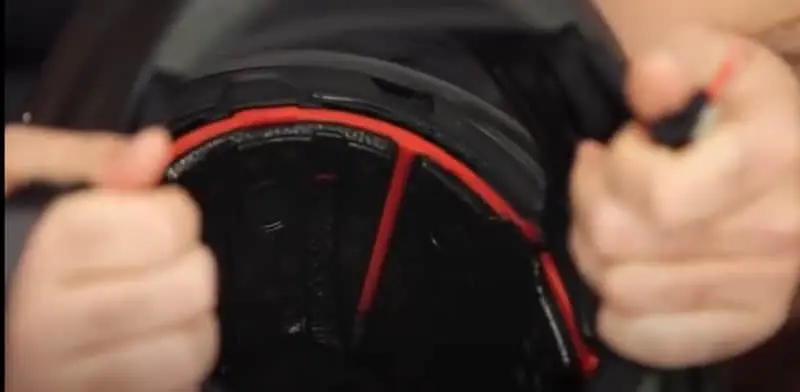
The Bell Race Star Flex DLX motorcycle helmet features dedicated speaker pockets on models from 2020 and newer, located right by your ears.
I installed a Sena Bluetooth system, and the speakers dropped right into place, making the setup quick and keeping the liner design smooth.
This upgrade is a big plus for anyone who wants music, calls, or intercom.
Comfort And Audio Experience With Bluetooth Systems
With the speaker pockets, I barely notice the speakers behind the cheek pads, though, after a few hours, I can feel a slight bump near my ear.
The speakers are still noticeable, but the comfortable optimal features help keep the pressure low.
On the highway, even with the speakers at full volume, I sometimes struggle to hear music clearly when wearing earplugs, which matches what others report.
Older Models Lack Speaker Space
If you have a motorcycle helmet before 2020, there are no dedicated speaker pockets, so you’ll need to fit speakers in less ideal spots or under the liner.
This can make this motorcycle helmet fit tighter and affect comfort, especially on long rides. Riders on forums say this was a common complaint before Bell updated the shell size and liner design.
| Model Year | Speaker Pockets | My Experience |
|---|---|---|
| 2020+ | Yes | Easy install, comfort optimal, minor bump |
| Pre-2020 | No | Hard to fit, tighter fit, less ideal |
The Bluetooth-ready speaker pockets are a key upgrade for modern riders.
If you want a motorcycle helmet that supports easy Bluetooth setup and keeps you connected, look for a 2020 or newer model with this feature.
Just know that audio can be quiet with high-speed earplugs, so you may want to test your system before a long trip.
Star Flex Wide Range Of Designs And Colors
The Race Star Flex Dix comes in a selection of colors and graphics, allowing you to pick a motorcycle helmet look that matches your style.
I’ve seen options like the Fasthouse Street Punk, Tantrum 2, and the Hello Cousteau Algae, which stands out with bright patterns and ocean-inspired art.
Matte Carbon Fiber Weave Adds Visual Appeal
Many designs show off the carbon fiber weave under a matte or gloss finish, which gives it a unique look.
I picked a model where the fiber shell is visible, and the pattern always gets attention at bike meets. The matte finish looks sharp but does pick up finger smudges, so I keep a cloth handy to wipe it down after handling.
| Design Feature | My Experience |
|---|---|
| Color Range | Wide selection, easy to find a personal style |
| Fasthouse Graphics | Bold, get compliments on rides |
| Hello Cousteau Algae | Unique, ocean-inspired, very eye-catching |
| Matte Carbon Weave | Looks sharp, shows smudges, and needs frequent wiping |
The color and graphic options make it easy to match your helmet’s look to your taste.
Star Flex FAQ
How Does The Bell Race Star Flex DLX
Fit At First?
This motorcycle helmet feels snug out of the box and needs a few hours or several short rides to break in. My cheeks felt squeezed at first, but the cheek pads softened up and became comfort optimal. Some forum riders mention pressure points or tightness, especially around the cheeks and ears, so trying on different shell sizes or swapping cheek pads can help.
Can I Wear Glasses With The Bell Race Star Flex DLX?
You can wear glasses since the liner design includes eyewear cutouts, but the snug cheek pads can make it tricky or uncomfortable for some users, especially with thick frames. I found that switching to thinner cheek pads made it easier to slide my glasses in, but others on forums still reported some rubbing or pressure.
How Well Does The ProTint Shield Work?
The Pro-tint shield works well in changing light, transitioning quickly from clear to tinted, and I rarely need to swap shields. Some riders find it’s not dark enough for low sun or too dark in bright rain or fog, so sunglasses may still be needed for sensitive eyes.
Is The Bell Race Star Flex DLX Noisy?
Noise levels are mixed and some find it loud, others say it’s manageable with earplugs, and the carbon fiber shell is a bit noisier than polycarbonate options. I notice wind noise at high speed, but with earplugs, it’s comfortable for any use.
Does The Bell Race Star Flex DLX Have Speaker Pockets?
Models from 2020 and newer have dedicated speaker pockets near the ears, making Bluetooth installation easy. If you have an older motorcycle
helmet, you’ll need to insert speakers in less ideal spots, which can affect comfort and audio quality.
What Safety Ratings Does The Bell Race Star Flex DLX Have?
It meets or exceeds DOT, Snell M2015, and ECE 22.06 standards, covering both street and track requirements. I checked the labels before my first race and all three were present.
How Does The Fit Compare To Other Bell Helmets?
The Race Star Flex has a race fit
, which is tighter than other Bell models of the same size, especially around the cheeks and temples. After upgrading from another Bell helmet
, I found the same snugger size, so I recommend trying one on or adjusting the cheek pads for an optimal fit.
The Bell Race Star Flex DLX delivers race-bred technology wrapped in street-practical features that serious riders will appreciate. You get a helmet that combines carbon fiber construction with advanced safety systems like the three-layer Flex impact liner and rotational energy management. Bell designed this helmet for riders who want track-level protection without sacrificing everyday usability.
Standout Features That Matter
You’ll find the included Panovision ProTint photochromatic shield saves you money and hassle by automatically adjusting to light conditions. The magnetic cheekpads make cleaning simple, while the lightweight carbon construction reduces neck fatigue during long rides. Bell’s speaker pockets in 2020+ models accommodate Bluetooth systems perfectly, and the DOT, Snell M2015, and ECE 22.06 certifications provide confidence in crash protection.
Important Considerations Before Purchase
You need to expect a very tight initial fit that requires significant break-in time, especially around the cheeks. The helmet can be noisy at highway speeds, and the ProTint shield has limitations in extreme lighting conditions. Finding replacement cheekpads in different thicknesses can be challenging, and the premium price puts this helmet above many competitors.
Worth The Investment For Serious Riders
You get exceptional value when you consider the included ProTint shield, premium materials, and advanced safety technology. The Bell Race Star Flex DLX stands out as a smart choice for riders who prioritize protection and appreciate thoughtful engineering details that enhance the riding experience.
More Details
Who Is The Bell Star For?
The Race Star Flex is made for riders who want race-level protection and comfort on both the track and street.
If you’re someone who values advanced safety like the three-layer flex liner, but also needs a helmet for daily rides or long trips, this lid fits that niche.
I found it fits best for intermediate oval head shapes, though it does feel a bit narrower than other brands, so those with rounder heads might want to try it before buying.
Technical Terms
3K Carbon Fiber
3K carbon fiber is a material made of bundles containing 1,000 individual carbon filaments woven together to form a strong, lightweight structure. This weave is used to provide high strength and low weight, improving both protection and comfort for the rider.
Shell
The shell is the outermost layer of the helmet, designed to absorb and distribute impact forces. The Bell Race Star Flex DLX, is made from 3K carbon fiber, which helps keep the helmet light and strong.
Flex Impact Liner
A flex impact liner is a multi-layered inner structure that manages energy from impacts at different speeds. Bell’s system uses three layers of different materials to absorb low, mid, and high-speed impacts, offering progressive protection for the rider’s head.
Three-layer system (EPO, EPP, EPS)
This refers to the use of three types of foam—Expanded Polyolefin (EPO), Expanded Polypropylene (EPP), and Expanded Polystyrene (EPS)—each tuned for a specific range of impact forces. The combination allows the liner to handle a broader spectrum of crash energies, improving safety.
Rotational Energy Management
Rotational energy management is a design approach that helps reduce the rotational forces transferred to the brain during an angled impact. This is achieved through the liner system, which allows slight movement between layers to absorb twisting forces.
Virus Cool Jade Power Mesh Liner
This is a removable, washable liner made with fabric infused with recycled jade, which creates a natural cooling effect. The liner is antibacterial, quick-drying, and helps keep the rider comfortable by reducing skin temperature and managing sweat.
Cheek Pads
Cheek pads are foam inserts help to secure it around the rider’s face. They’re triple-density for comfort and safety and use magnets for easy removal and cleaning.
Magnefusion Magnetic Cheek Pads
This system uses magnets to hold the cheek pads in place, making them easy to remove for cleaning or in emergencies. The design also lets emergency responders quickly pull out the pads before removing the helmet from an injured rider.
Panovision Viewport
The Panovision viewport is a widened and taller visor opening that provides a larger field of vision compared to standard helmets. This helps riders see more of the road and surroundings without needing to turn their head as much.
ProTint Photochromatic Face Shield
A ProTint shield is a visor that automatically changes its tint in response to light conditions, becoming darker in bright sunlight and clearer in low light. This feature reduces the need to swap visors and helps maintain clear vision in varying environments.
Ventilation (Twin-Port Chin, Brow, Top Vents, Rear Exhausts)
This refers to the system of adjustable air intakes and exhausts that manage airflow through the helmet. These vents help keep the rider cool and reduce fogging by circulating air across the head and out the back of the helmet.
Double D-Ring Strap
A double D-ring strap is a secure chin strap system using two metal rings to fasten the helmet. It’s a standard closure method in racing and high-performance helmets for its reliability and adjustability.
Speaker Pockets
Speaker pockets are recessed areas near the ears, designed to hold speakers for Bluetooth communication systems. Models from 2020 onward include these pockets, making it easier to install audio devices without discomfort.
DOT, Snell M2015, and ECE 22.06 Certifications
These are safety standards that meet or exceed. DOT is the US Department of Transportation standard, Snell M2015 is a voluntary, rigorous US standard, and ECE 22.06 is a widely recognized European safety certification, all indicating it has passed impact and safety tests.
Intermediate Oval Head Shape
This term describes the internal shape, which is slightly longer front-to-back than side-to-side. It’s designed to fit most North American and European head shapes comfortably.
Raceview Ergonomics
Raceview ergonomics means the fit and visor position are optimized for a tucked, forward-leaning riding posture. This helps sport and track riders maintain clear vision and comfort when riding aggressively.
EPS Liner
EPS stands for Expanded Polystyrene, a foam material used in helmet liners to absorb impact energy. The Bell Race Star Flex DLX uses six EPS liner sizes to fine-tune fit and protection for different head sizes.
Titanium D-Rings
Titanium D-rings are lightweight, strong metal rings used in some helmet strap systems. Compared to steel rings, they provide secure closure and reduce overall weight.
Emergency Release System
This safety feature allows emergency responders to remove the cheek pads before taking off the helmet, reducing the risk of further injury to the rider’s head or neck after a crash.
Breath Deflector
A breath deflector is a small insert inside the helmet that directs exhaled air away from the visor. This helps prevent fogging, especially in cold or humid conditions.
Visor Detents
Visor detents are the preset positions where the visor can be held open or closed. Limited detents mean fewer options for partially opening the visor for airflow or anti-fogging.
Rear Spoiler
A rear spoiler is an aerodynamic extension at the back of the helmet. It helps manage airflow, reduce lift, and improve stability at high speed, but some users have reported issues with it coming unglued.
Pinlock
A Pinlock is a popular anti-fog insert that attaches to the inside of a helmet visor. The Bell Race Star Flex DLX does not include Pinlock compatibility; instead, it relies on its own anti-fog coating.
Maintenance
The liner and cheek pads come out for washing, and the magnetic cheek pads make removal simple. I clean the visor often since the carbon fiber finish shows smudges, and the shield pops off with a button for quick cleaning.
Replacement cheek pads are available but sometimes hard to find in stock, and a few users have had to contact Bell for warranty help with rear spoilers or liner cracks.
User Feedback
Most riders—including me—notice the helmet is tight at first, especially in the cheeks, but it becomes comfort optimal after a week of riding.
The Pro-Tint shield is a standout for changing light, though some wish it got darker for low sun or wasn’t as dark in rain.
Ventilation is strong for hot weather, noise varies (earplugs help), and the magnetic features make cleaning and fit tweaks easy.
The lightweight and aerodynamic shape reduces fatigue on long rides, and many feel the safety features are worth the price—even if some find the cost high or wish for more visor detents and deeper speaker pockets.
| User Feedback | Example |
|---|---|
| Initial Fit | Tight at first, breaks in after a week |
| Cheek Pads | Snug, sometimes need thinner pads for glasses |
| ProTint Shield | Great for changing light, but not always dark enough |
| Ventilation | Strong, especially chin vent, but can be drafty |
| Noise | Mixed, earplugs recommended |
| Magnetic Features | Cheek pads and strap tidy are easy and premium |
| Weight | Reduces neck fatigue |
| Safety | Flex liner inspires confidence |
| Price | High, but many say it’s worth it for helmet features |
| Minor Complaints | Shallow speaker pockets, visor detents, spoiler glue |
The Bell Race Star Flex DLX delivers on both fronts if you want a full-face helmet that balances race-day protection with daily comfort.
I’d recommend it to anyone who wants advanced safety, premium features, and a helmet that feels solid on both a racer track and a long day ride.

